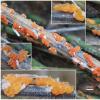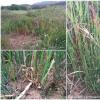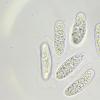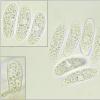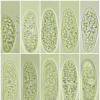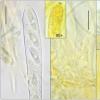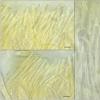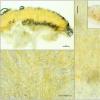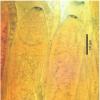
16-11-2025 21:09
 Robin Isaksson
Robin Isaksson
Anyone recognize this acc. to pictures.? Found on

14-11-2025 16:26
 Marian Jagers
Marian Jagers
Hello everyone, On dead wood of Cytisus scoparius

15-11-2025 23:22
Mario FilippaHello,this is what I think to be Hymenoscyphus mac

15-11-2025 20:25
 Riet van Oosten
Riet van Oosten
Hello, Found by Laurens van der Linde, Nov. 2025

14-11-2025 18:31
 Lothar Krieglsteiner
Lothar Krieglsteiner
Hello,can somebody provide me with a file of:Rothe

12-11-2025 09:25
 Viktorie Halasu
Viktorie Halasu
Hello, I need help with a pale terrestric Pseudom

11-11-2025 20:16
Bohan JiaHi, lastly I have found these tiny yellow decayin

09-11-2025 13:20
Hello.A tiny ascomycete, appearing as erupting gra
Encontré este curioso ascomycete a mediados del mes de mayo, en la base de los tallos aun sujeto a la planta Equisetum ramosissimum, en un lugar húmedo cerca de un rio, en la Serranía de Ronda, sur de España.
Apos de hasta 1mm aproximadamente
Esporas elipsoidales, en ocasiones curvadas, multigutuladas.
(20,64) 23,08 - 29,24 (30,25) × (7,80) 8,30 - 9,45 (10,10) µm
Q = (2,56) 2,63 - 3,32 (3,57) ; N = 30
Me = 26,06 × 8,88 µm ; Qe = 2,95
Ascos con ocho esporas, con croziers y amiloide en IKI
(115,74) 153,45 - 179,89 (206,06) × (17,28) 17,65 - 19,84 µm
Paráfisis ensanchándose hacia el ápice (hasta 5,61 µm), con contenido amarillento en su interior a modo de pequeñas gutulas.
Stamnaria americana es similar, pero esta presenta el poro apical del asca IKI negativo, según he leído esta es una especie diferente, muy probablemente mi colección corresponda con una de Enrique Rubio de Asturias en Equisetum hyemale (Stamnaria sp, Biodiversidad Fúngica del Parque Natural de Somiedo).
Para guardar en mis archivos, conocéis si existe un epíteto valido para esta especie??
Gracias anticipadas y saludos a todos
Curro Valencia

Estupendo!! Muchas gracias por la informacion.
Saludos
Curro
And it is apparently the very same kind of Stamnaria as Enrique's specimens.
I "reviewed", respectively watched photos of ca. 450 reports of Equisetum ramosissimum from nearby the whole native range at iNaturalist forum. I couldn't find evidence for this "S. laetissima" on E. ramosissimum, except a sole one from South Africa.
Could you please add this finding of yours as observation to Genus Stamnaria identified at genus level?
Please have as well a look at other findings of Horsetails inhabited by parasitic kinds of Stamnaria
Best regards
Erwin
Muchas gracias por toda la información.
Si, por supuesto que puedes agregar esta colección a su observación al Género Stamnaria identificado a nivel de género, si necesitas información más detallada, puedo adjuntarle los datos de esta especie.
Gran trabajo de recopilación de especies de Stamnaria, gracias por compartirlo.
Saludos y gracias de nuevo por su interés.
Curro Valencia
¡Gracias por su permiso para presentar este hallazgo en el sitio web de iNaturalist! Espero haber entendido eso correctamente. Bien, necesitaría las fechas exactas del hallazgo.
Otros comentarios sobre esta hermosa colección seguirán en inglés, porque desafortunadamente no hablo español. (Traducción de Google)
As commented before, i do still suppose you got the nominative type of Stamnaria laetissima in Spain. Thy type collection (Herb. Viv. Mycol. 1024) from South Tyrol, Italy, had grown on same host species, Equisetum ramosissimum.
Qe of 2,95 and amyloid apical ring is in agreement with my results, but Me of ascospores is considerably larger. This will, and may in part be due to shrinking of spores in dead state, but i do assume there will be differences of geographic races, respectively infraspecific types of S. laetissima.
I need to controll my old measurings (not at hand at moment), but average spore length of ca. 26 µ seems to be nearer to average S. americana, average width of ca. 8,9 µ is even wider, leading to Qe matching the nominative S. laetissima.
In fact this "Stamnaria laetissima" (aggr.) got a vast native range, with different kinds of hosts (E. ramos., hyemale, laevigatum, +??), and i separated the (as well unpublished) "subsp. tenuispora", inhabiting E. hyemale in more northern Europe, with narrower spores.
Thus it might happen to be split into (infra-) specific units in future.
(Typical) S. americana is well characterised by having lost amyloid ascus ring, apparently bound to E. hyemale in cooler and relatively humid climates, bearing ascocarps in cold(er) season in general.
Still there is the sole population in Hokkaido, Japan, which got amyloid rings, growing fruitbodies in spring, and matches typical S. americana in spore characters.
Since that specific border between S. laetissima and S. americana (further adapted) is hard to draw, at least on morphologic reason and compared characters.
Best regards and wishes
Erwin
please have a look at my prior statements, and share your thought about.
Perhaps S. laetissima will need splitting in several (infra-)specific taxa, who knows without thorough investigation?
I do assume that typical J- S. americana is a specific segregation from the older S. laetissima, having lost it's amyloid apical structure in adaption to ecologic situation within habitats. As this structure was not essential anymore, it got lost.
I accepted the Hokkaido population to represent "amyloid americana", however, i may not be certain to draw the specific boderline. Even more so, since Me of S. laetissima ascospores is apparently variable, Hokkaido population doesn't grow ascocarps in cold season.
So this may hardly be cleared without genetic comparison.
Beste Grüße und Wünsche
Erwin

yes, a complex group, and it took me a while to conclude to separate the narrow spore type as (then var.) "tenuispora" from typical S. laetissima.
I watched the saved excel file and found Danny's sequence of DH665 (not 665b so far), which came from St. Petersburg region, coll. V.A. Melnik, 23.08.2000.
So this might be a European J+ race of S. americana, by that a pendant to the Hokkaido population, what made "ssp. tenuispora" superfluous as synonym, but i will stay cautious untill further evidence. I proved as well a single "tenuispora" from Scarborough, E England, coll. G.E. Massee.
"The one from Wisconsin on E. ?hyemale differs from them by 2-7 nt": I only do know usual J- S. americana from Wisconsin, don't remember on any S. laetissima confirmed upon ascocarps from there. Do you know data of this specimen, could it have been from another state?
In case morphologic typical S. americana varied considerably more in genetics, than it differed from J+ S. laetissima, this made all likewise populations to a single species.
Maybe the Wisconsin? specimen is in fact American S. laetissima inhabiting E. laevigatum, we will see.
Please see linked observations of parasitic Stamnaria, including indirect reports. There is only one on E. ramosissimum, reported from south Africa. There are as well two collections from Java, Indonesia on E. ramosissimum, and i think to remember these shall be J+.
Definitely a challenge, it will get cleared by time.
Kind regards
Erwin
Si, entendiste bien, puedes presentar esta colección en iNaturalist!, Te adjunto la fecha exacta del hallazgo, 22-04-20, este año resulto una especie muy frecuente en el lugar, siempre en la base de plantas de E. ramosissimum que se encontraban en lugares soleados y despejados a lo largo del rio.
Tengo la colección deshidratada en mi herbario personal, si Danny está interesado, puedo enviarle parte de la colección.
De nuevo muchas gracias por toda la información interesante que aportáis!! No parece fácil, pero seguro que con el tiempo, despejáis todas las dudas que se esconden en este grupo tan complejo. Ánimo amigos!!
Siento no poder expresarme en inglés.
Saludos cordiales
Curro.
¡Muchas gracias por el permiso para publicar este hallazgo junto con sus fotos!
Tales Ascomicetos son muy raramente percibidos y recolectados, estoy contento con cada observación.
Para el foro iNaturalist, necesito la posición geográfica exacta para la entrada en el mapa. El tiempo aproximado es posible pero no necesario.
No sé si Danny ha secuenciado tales hallazgos en Equisetum ramosissimum. ¿Tampoco puedo juzgar si la región ITS es adecuada para diferenciar entre especies de este género?
Stamnaria contiene varias especies, claramente diferentes, la mayoría de las cuales aún no se han publicado. Mis estudios sobre esto comenzaron en 1994 con mi tesis de diploma, pero desafortunadamente fue interrumpida una y otra vez.
Saludos y deseos
Erwin
Ok, te adjuntare los datos junto con las coordenadas, tengo los datos recopilados en el teléfono móvil, pero este se encuentra en el taller de reparaciones (problemas con la pantalla) hoy salgo de viaje y hasta mediados de la semana que viene no regresaré, el jueves día 16 te adjuntaré los datos.
Volveré pronto por aquí.
Saludos
Curro
Te adjunto los datos de la especie con las coordenadas exactas.
Un abrazo
Curro
Stamnaria laetissima
Datos
País: España
Provincia: Málaga
Municipio: Ronda
Topónimo: Zona de Navares-Tejares
Coordenadas: 36°43'50.0"N 5°07'43.8"W Altitud: 685metros
Google maps: 36.730560, -5.128830
Ecología: En la base de los tallos aun sujetos a la planta Equisetum ramosissimum, en una zona inundable por las aguas en épocas de fuertes lluvias, cerca del rio Guadalevín.
Fecha de recolección: 22-04-2020
Recolector: F.J Valencia
Thanks a lot for telling all essential data of your specimen, which i presented now as observations of Stamnaria (laetissima) and Equisetum ramosissimum.
Best wishes and regards
Erwin
Yesterday i went to the sole site i know about, where Stamnaria laetissima was collected in recent days, by T. Barta on 29.08.1996. Soon therafter his collection was directed to me so i could identify it. You may find report and photos of at iNaturalist and Flickr Album.
Links to Danny's gene sequencing displayed at GenBank provided at iNaturlist observation.
Despite hoards of thursty mosquitoes attacked me, i took photos and a large collection comprising lots of ascocarps and conidiomata. So if anyone needs samples, please let me know.
Best regards
Erwin

Earlier on 09.08.2020 i checked another site where E. ramosissimum had been collected together with some ascocarps of S. laetissima.
Collection data: J. Breidler, 30.06.1867, Niederösterreich, an sandigen Stellen bei Moosbrunn nächst Wien. Metlesics, 02,.08.1959, Niederösterreich, bei Moosbrunn.
For sure i don't know accurate locations of these specimen, but i searched again at the protected wetland "Naturdenkmal Brunnlust". When i was there, about 20 ys ago, the E. ramosissimum population consisted of way more, perhaps even larger grown shoots.
But i could not find any Stamnaria or seeming indication.
A few photos of the horsetail are gathered at my Flickr album of Equisetum ramosissimum.
Indeed, ascomata are likely to survive for a while in dry state, so one could prove characters at living state. Zotto, i got no microscope or other equipment for proving characters and taking enlarged photos. But i would send samples for any purpose in case you ore someone else wished.
Beste Grüße, best regards
Erwin

